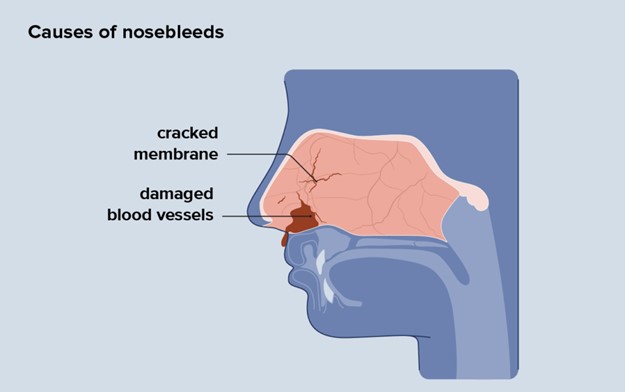A woman is in her seventh month of pregnancy.
She has been reporting nasal congestion and occasional epistaxis. The nurse suspects that:
This is a normal respiratory change in pregnancy caused by elevated levels of estrogen.
This is an abnormal cardiovascular change, and the nosebleeds are an ominous sign.
The woman is a victim of domestic violence and is being hit in the face by her partner.
The woman has been using cocaine intranasally.
The Correct Answer is A
This is a normal respiratory change in pregnancy caused by elevated levels of estrogen. Estrogen increases blood flow and causes the nasal mucosa to swell, leading to congestion and nosebleeds. This condition is called pregnancy rhinitis and affects up to 20% of pregnant women.

Choice B is wrong because this is not an abnormal cardiovascular change, and the nosebleeds are not an ominous sign. They are usually harmless and do not affect the pregnancy outcome.
Choice C is wrong because there is no evidence that the woman is a victim of domestic violence.
This is a serious accusation that should not be made without proper assessment and screening.
Choice D is wrong because there is no indication that the woman has been using cocaine intranasally. Cocaine use can cause nasal damage and bleeding, but it can also have other signs and symptoms such as agitation, euphoria, dilated pupils, increased heart rate and blood pressure, and risk of miscarriage or preterm labor.
Nursing Test Bank
Naxlex Comprehensive Predictor Exams
Related Questions
Correct Answer is ["B","D"]
Explanation
Sleepiness or fatigue and puffiness around the eyes are symptoms associated with hypothyroidism. Hypothyroidism is a condition where the thyroid gland does not produce enough thyroid hormones, which regulate the body’s metabolism and energy levels.
Choice A is wrong because weight loss is more likely to occur in hyperthyroidism, a condition where the thyroid gland produces too much thyroid hormones.
Choice C is wrong because diarrhea is also more likely to occur in hyperthyroidism, as the excess thyroid hormones speed up the digestive system.
Choice E is wrong because limited hair growth is not a specific symptom of hypothyroidism. Hair loss or thinning may occur in both hypothyroidism and hyperthyroidism, depending on the severity and duration of the condition.
Normal ranges for thyroid hormones are:
- TSH: 0.4 to 4.0 mIU/L
- T3: 100 to 200 ng/dL
- T4: 4.5 to 11.2 mcg/dL
Correct Answer is A
Explanation
Assess the parents’ anxiety level and readiness to learn. This is because the nurse needs to evaluate the parent’s emotional state and their ability to comprehend and retain information before providing any teaching.
The nurse should also consider the parent'slearning style, cultural background, and literacy level.
Choice B is wrong because gathering literature for the parents is not the first action. The nurse should first assess the parents’ needs and preferences and then select appropriate materials that match their level of understanding and language.
Choice C is wrong because securing a quiet place for teaching is not the first action. The nurse should first assess the parents’ readiness to learn and then choose a suitable environment that minimizes distractions and promotes comfort.
Choice D is wrong because discussing the plan with the nursing team is not the first action. The nurse should first assess the parents’ anxiety level and readiness to learn and then collaborate with other health care professionals to provide consistent and accurate information.
Whether you are a student looking to ace your exams or a practicing nurse seeking to enhance your expertise , our nursing education contents will empower you with the confidence and competence to make a difference in the lives of patients and become a respected leader in the healthcare field.
Visit Naxlex, invest in your future and unlock endless possibilities with our unparalleled nursing education contents today
Report Wrong Answer on the Current Question
Do you disagree with the answer? If yes, what is your expected answer? Explain.
Kindly be descriptive with the issue you are facing.
